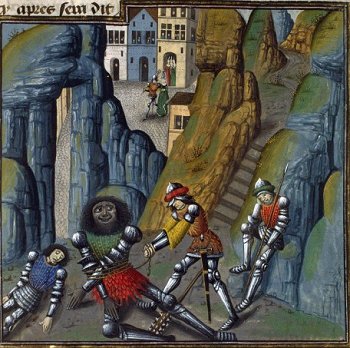 |
| The Capture of Cerberus (image from Wikimedia) |
In the Vaults of Pahvelorn game, no XP is awarded for defeating monsters. From a game design point of view, this is probably the only house rule with a potential for major unintended consequences, so I am approaching it enthusiastically but with caution. The main intention is to break the primary association between killing monsters and advancing in the game.
Sometimes you do just want to kill creatures and take their stuff, but that is not the only profitable way to interact with strangers. Here are some other possibilities.
- Minions. Many intelligent foes would be just as happy working for you as against you, if you make it worth their while. Payment is a good start, but subdual and enslavement can also work sometimes, and fighting against a someone’s enemies is always a decent way to get on their good side. The magical option is traditionally charm person or charm monster.
- Mounts. Some rideable creatures are intelligent and can be bargained with. See the entry on retainers above. If not, feeding creatures is a good opening gambit (though you need to discover what they eat first, if you don’t want to offend them). Unintelligent creatures will require some training time, and paying an animal trainer (or beast master, if you can find one) can help speed up that process. The magical method is charm monster.
- Taxidermy. Preserved monsters are a sign of wealth, power, and erudition. It is considered especially chic to replace eyes with precious gem stones. Specimens of The Beautiful People are particularly prized by collectors.
- Resources. While you won’t generally encounter NPCs that send you on quests for 10 hell hound ears (or whatever), many creatures do provide components of value. For example, fire beetles contain an unstable compound useful in creating high quality oil and other combustibles. Poison, if safely extracted and stabilized, is also always valuable in the black market (if you don’t want to use it yourself). Sometimes, a poison sample is required to formulate an effective antitoxin. If in doubt, haul a carcass back to a sage and get it examined.
- Gladiators. Pitting slaves or monsters against each other is good sport in some lands, though it is not permitted (publicly) in Zorfath.
- Menageries. Travelling circuses and menageries will often pay good coin for captured or subdued beasts. Sometimes, they just transport them to distant customers (zoos, arenas, sorcerers) while other times they are trained as circus creatures. Enslaving and selling creatures will not endear you to their relatives, however.
- Dissection. Useful for a bonus on spell research, and perhaps for things like the creation of chimeras. I have an earlier post about this too.
Any other ideas for how to make use of monsters?
